1988 PONTIAC FIERO distributor
[x] Cancel search: distributorPage 670 of 1825
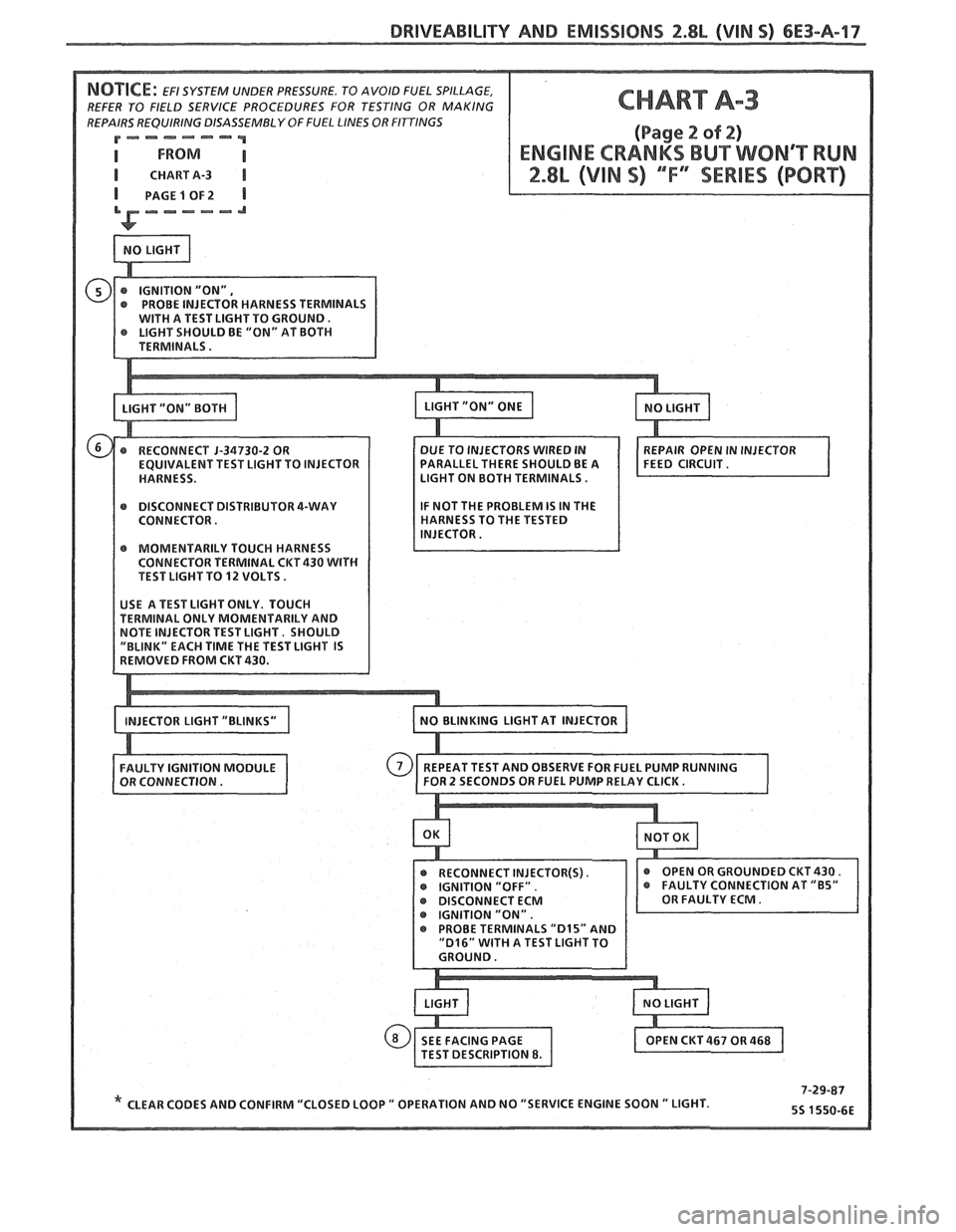
DRIVEABILITY AND EMISSIONS 2.8L (VIM 5) 6E3-A-17
REFER TO FIELD SERVICE PROCEDURES FOR TESTING OR MAKING
REPAIRS REQUIRING DISASSEMBLY
OFFUEL LINES OR FInlNGS
P=---=-'-"""
I CHARTA-3 I
PAGE 1 OF2
ARALLEL THERE SHOULD BE A IGHT ON BOTH TERMINALS.
r DISCONNECT DISTRIBUTOR 4-WAY
CONNECTOR.
r MOMENTARILY TOUCH HARNESS
CONNECTOR TERMINAL CKT 430 WITH TEST LIGHT TO 12 VOLTS.
* CLEAR CODES AND CONFIRM "CLOSED LOOP " OPERATION AND NO "SERVICE ENGINE SOON " LIGHT.
Page 671 of 1825

6E3-A-I8 2.8b (VIN 5) DRIVEABILITY AND EMISSIONS
PUMP INLET FILTER
IN-TANK PUMP
FUEL
PRESSURE CONNECTOR
CHART A-7
(Page 4 of 2)
FUEL SYSTEM DsAGNOSBS
2.8L (VIN S) ""FYSERBES (PORT)
Circuit Description:
When the ignition switch is turned "ON", the electronic control module (ECM) will turn "ON" the in-tank
fuel pump. It will remain "ON" as long as the engine is cranking or running, and the ECM is receiving
HE1
distributor reference pulses.
If there are no reference pulses, the ECM will shut "OFF" the fuel pump within
2 seconds after key "ON" or
engine stopped.
The pump will deliver fuel to the fuel rail and injectors, then to the pressure regulator, where the system
pressure is controlled to about 234 to 317
kPa (34 to 46 psi). Excess fuel is then returned to the fuel tank.
Test Description: Numbers below refer to circled
numbers on the diagnostic chart.
1. Use pressure gage 5-34730-1. Wrap a shop towel
around the fuel pressure tap to absorb any small
amount of fuel leakage that
may occur when
installing the gage.
Ignition "ON", pump pressure should be 280-325
kPa (40.5-47 psi). This pressure is controlled by
spring pressure within the regulator assembly.
2. When the engine is idling, the manifold pressure
is low (high vacuum) and is applied to the fuel
regulator diaphragm. This will offset the spring
and result in a lower fuel pressure.
'This idle
pressure will vary somewhat depending on
barometric pressure, however, the pressure idling
was less indicating pressure regulator control.
3. Pressure that continues to fall is caused by one of
the following:
In-tank fuel pump check valve not holding.
@ Pump coupling hose or pulsator leaking.
Fuel pressure regulator valve leaking.
@ Injector sticking open. 4.
An injector sticking open can best be determined
by checking for a fouled or saturated spark
plug(s).
If a leaking injector can not be determined by a
fouled or saturated spark plug the following
procedure should be used.
e Remove Plenum, cold start valve and remove
fuel rail bolts. Follow the procedures in the
fuel control section of this manual, but leave
fuel lines connected.
@ Reconnect cold start valve.
@ Connect a hose to valve nozzle and insert into
a gasoline container.
@ Lift fuel rail out just enough to leave injector
nozzles in the ports.
CAUTION: BE SURE INJEePOR(S) ARE NOT ALLOWED
PO SPRAY ON ENGINE AND THAT INJECTOR
RETAINING
CLIPS ARE INTACT. PHIS SHOULD BE
CAREFULLY
FOLLOWD PO PREVENT FUEL SPRAY ON'
ElZIGlNE WHICH WOULD CAUSE A FIRE HAZARD.
@ Pressurize the fuel system.
@ I.if't each side of rail up and observe for
injc~ctot-l.) It.ulting
Page 675 of 1825

6E3-A-22 2.8L (VlN S) DRIVEABILITY AND EMISSIONS
COLD START FUEL INJECTION
SWITCH CONNECTOR
TO NEUTRAL START SWITCH
OR CLUTCH START SWITCH
- - COLD START FUEL
- CLOSED BELOW 35°C.
8 SEC. TIME LIMIT
COOLANT
CHART A-9
COLD START VALVE
2.8b (VIN S) ""FYSERIES (PORT)
Circuit Description:
The cold start valve is used to provide additional fuel during the crank mode to improve colt1 start-ups. This
circuit is important when engine coolant temperature is low because the other injectors are not pulsed
"ON"
long enough to provide the needed amount of fuel to start.
The circuit is activated only in the crank mode. The power is supplied directly from the starter solenoid and
is protected by a fuse. The system is controlled by
a cold start fuel injection switch which provides a ground path
for the valve during cranking when engine coolant is below
95°F (35°C).
The cold start fuel injection switch consists of a bimetal material which opens at a specified coolant
temperature. This bimetal is also heated by the winding in the switch which allows the valve to stay
"ON" for 8
seconds at -20°C (-5°F) coolant. The time the switch will stay closed varies inversely with coolant temperature.
In other words, as the coolant temperature goes
LIP, the cold start valve "ON" time goes down.
Pest Description: Numbers below refer to circled The amount of pressure drop depends on the
numbers on the diagnostic chart.
temperature of the engine.
1. Disconnecting the distributor 4-way connector 2. This test will determine the continuity through
will disable the other injectors. the switch to ground.
Page 701 of 1825

6E3-A-48 2.8L (VIN S) DRIVEABILITY AND EMISSIONS
DISTRIBUTOR
CODE 42
ELECTRONIC SPARK TIMING (EST) FAULT
2.8L (VIN S) ""F3"lES (PORT)
Circuit Description:
When the system is running on the ignition module, that is, no voltage on the bypass line, the ignition
module grounds the EST signal. The ECM expects to see no voltage on the EST Line during this condition.
If it
sees a voltage, it sets Code 42 and will not go into the EST mode.
When the rpm for EST is reached (about 400
rpm), and bypass voltage applied, the EST should on longer be
grounded in the ignition module so the EST voltage should be varying.
If the bypass line is open or grounded, the ignition module will not switch to EST mode so the EST voltage
will be low and Code 42 will be set.
If the EST line is grounded, the ignition module will switch to EST, but because the line is grounded there
will be no EST signal.
A Code 42 will be set.
f est Description: Numbers below refer to circled
numbers on the diagnostic chart.
1. Code 42 means the ECM has seen an open or short
to ground in the EST or bypass circuits. This test
confirms Code 42 and that the fault causing the
code is present.
2. Checks
for a normal EST ground path through the
ignition module, An EST CKT 423 shorted to
ground will also read less than 500 ohms;
however, this will be checked later.
3. As the test light voltage touches CKT 424, the
module should switch causing the ohmmeter to
"overrange" if the meter is in the 1000-2000
oh~ns
position. Selecting the 10-20,000 ohms position
will indicate above 5000 ohms. The important
thing is that the
moclule "switched" 4.
The module did not switch and this step checks for:
s EST CKT 423 shorted to ground.
@ Bypass CKrI' 424 open.
@ Faulty ignition module connection or module.
5. Confirms that Code 42 is a faulty ECM and not an
intermittent in
CKTs 423 or 424.
Diagnostic Aids:
The "Scan" tool does not have any ability to help
diagnose a Code 42 problem.
A PROM not fully seated in the ECM can result in
a Code 42.
Refer to "Intermittents" in Section "B".
Page 711 of 1825
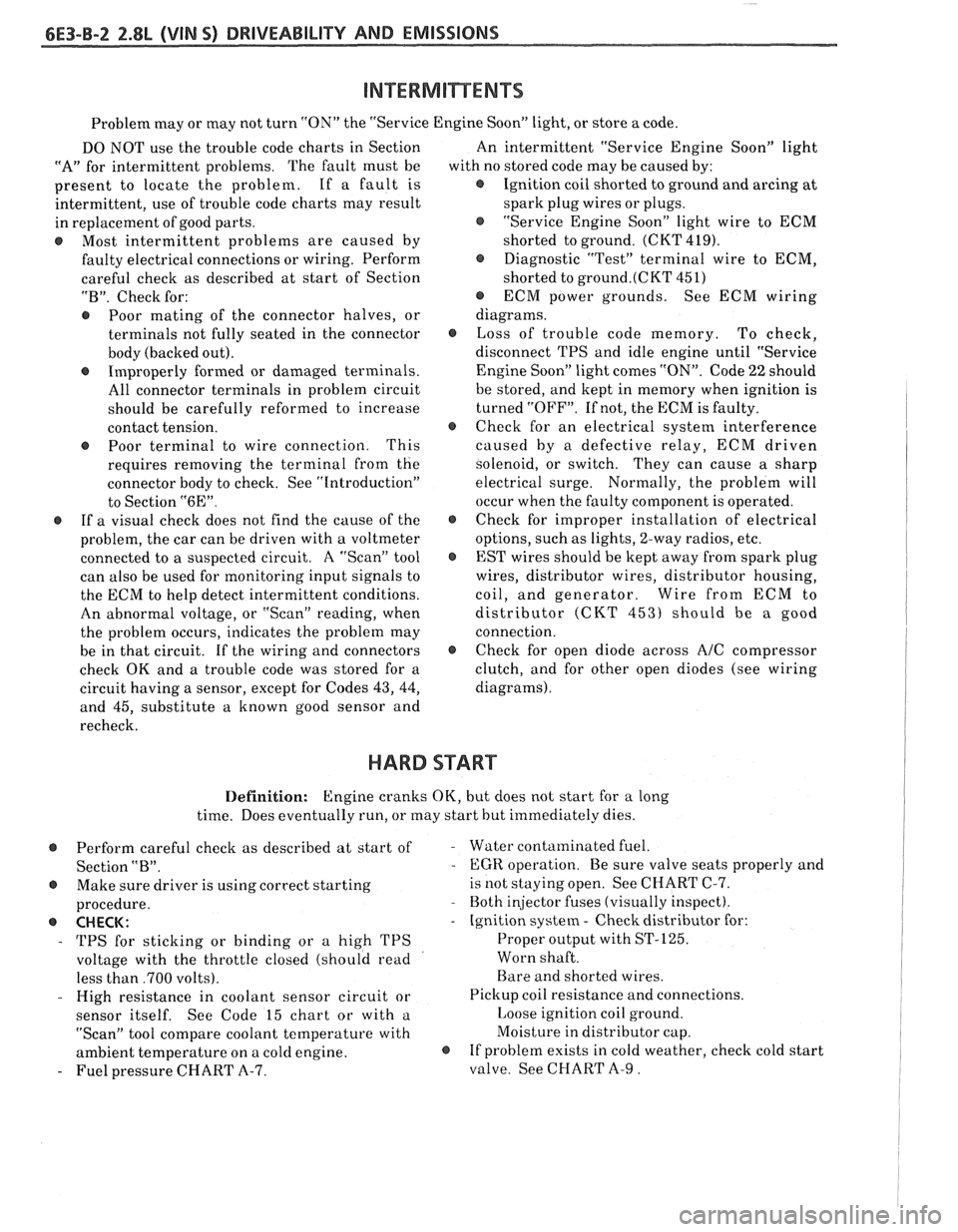
6E3-B-2 2.8L (VIN 5) DRIVEABILITY AND EMISSIONS
Problem may or may not turn "ON" the "Service Engine SoonJ' light, or store a code.
DO NOT use the trouble code charts in Section
"A" for intermittent problems. The fault must be
present to locate the problem. If a fault is
intermittent, use of trouble code charts may result
in replacement of good parts.
@ Most intermittent problems are caused by
faulty electrical connections or wiring. Perform
careful check as described at start of Section
"B". Check for:
@ Poor mating of the connector halves, or
terminals not fully seated in the connector
body (backed out).
@ Improperly formed or damaged terminals.
All connector terminals in problem circuit
should be carefully reformed to increase
contact tension.
@ Poor terminal to wire connection. This
requires removing the terminal from the
connector body to check. See "Introduction"
to Section
"6E".
@ If a visual check does not find the cause of the
problem, the car can be driven with a voltmeter
connected to a suspected circuit. A "Scan" tool
can also be used for monitoring input signals to
the ECM to help detect intermittent conditions.
An abnormal voltage, or "Scan" reading, when
the problem occurs, indicates the problem may
be in that circuit. If the wiring and connectors
check OK and a trouble code was stored for a
circuit having a sensor, except for Codes
43, 44,
and 45, substitute a known good sensor and
recheck. An
intermittent "Service Engine Soon" light
with no stored code may be caused by:
@ Ignition coil shorted to ground and arcing at
spark plug wires or plugs.
@ "Service Engine Soon" light wire to ECM
shorted to ground. (CKT 419).
@ Diagnostic "Test" terminal wire to ECM,
shorted to
ground.(CKT 451)
@ ECM power grounds. See ECM wiring
diagrams.
@ Loss of trouble code memory. To check,
disconnect TPS and idle engine until "Service
Engine Soon" light comes "ON". Code
22 should
be stored, and kept in memory when ignition is
turned "OFF". If not, the ECM is faulty.
@ Check for an electrical system interference
caused by a defective relay, ECM driven
solenoid, or switch. They can cause
a sharp
electrical surge. Normally, the problem will
occur when the faulty component is operated.
@ Check for improper installation of electrical
options, such as lights, 2-way radios, etc.
@ EST wires should be kept away from spark plug
wires, distributor wires, distributor housing,
coil, and generator. Wire from ECM to
distributor (CKT
453) should be a good
connection.
@ Check for open diode across A/C compressor
clutch, and for other open diodes (see wiring
diagrams).
HARD START
Definition: Engine cranks OK, but does not start for a long
time. Does eventually run, or may start hut immediately dies.
@ Perform careful check as described at start of -
Section "B".
@ Make sure driver is using correct starting
procedure.
@ CHECK:
- TPS for sticking or binding or a high TPS
voltage with the throttle closed (should read
less than
,700 volts).
- High resistance in coolant sensor circuit or
sensor itself. See Code 15 chart or with
a.
"Scan" tool compare coolant temperature with
ambient temperature on
a cold engine. 8
- Fuel pressure CHART A-7. Water contaminated
fuel.
EGR operation. Be sure valve seats properly and
is not staying open. See CHART C-7.
Both injector fuses (visually inspect).
Ignition system
- Check distributor for:
Proper output with ST-125.
Worn shaft.
Bare and shorted wires.
Pickup coil resistance and connections.
Loose ignition coil ground.
Moisture in distributor cap.
If problem exists in cold weather, check cold start
valve. See CHART A-9.
Page 712 of 1825
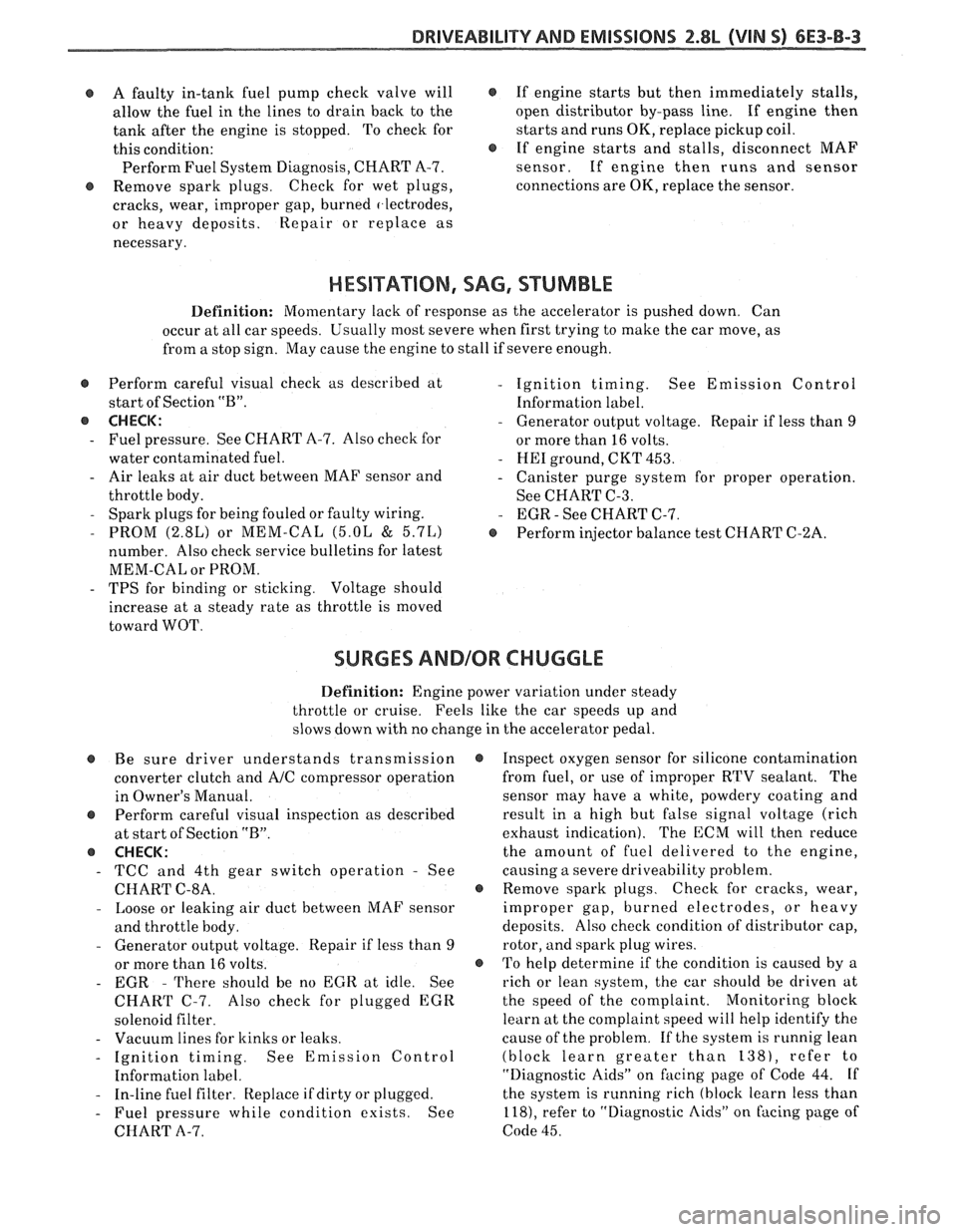
DRIVEABILITY AND EMISSIONS 2.8L (VIN S) 6E3-B-3
e A faulty in-tank fuel pump check valve will @ If engine starts but then immediately stalls,
allow the fuel in the lines to drain back to the open
distributor by-pass line. If engine then
tank after the engine is stopped. To check for starts
and runs OK, replace pickup coil.
this condition:
@ If engine starts and stalls, disconnect MAF
Perform Fuel System Diagnosis, CHART A-7. sensor. If engine then runs and sensor
@ Remove spark plugs. Check for wet plugs, connections are OK, replace the sensor.
cracks, wear, improper gap, burned
f lectrodes,
or heavy deposits. Repair or replace as
necessary.
HESITATION, SAG, STUMBLE
Definition: Momentary lack of response as the accelerator is pushed down. Can
occur at all car speeds.
Usually most severe when first trying to make the car move, as
from a stop sign. May cause the engine to stall if severe enough.
Perform careful visual check as described at
start of Section
"B".
a CHECK:
- Fuel pressure. See CHART A-7. Also check for
water contaminated fuel.
- Air leaks at air duct between MAF sensor and
throttle body.
- Spark plugs for being fouled or faulty wiring.
- PROM (2.8L) or MEM-CAL (5.OL & 5.7L)
number. Also check service bulletins for latest
MEM-CAL or PROM.
- TPS for binding or sticking. Voltage should
increase at a steady rate as throttle is moved
toward WOT.
- Ignition timing. See Emission Control
Information label.
- Generator output voltage. Repair if less than 9
or more than 16 volts.
- HE1 ground, CKT 453.
- Canister purge system for proper operation.
See CHART C-3.
- EGR - See CHART C-7.
@ Perform injector balance test CHART C-2A.
SURGES AND/OR CHUGGLE
Definition: Engine power variation under steady
throttle or cruise. Feels like the car speeds up and
slows down with no change in the accelerator pedal.
Be sure driver understands transmission
converter clutch and
A/C compressor operation
in Owner's Manual.
e Perform careful visual inspection as described
at start of Section
"B".
CHECK:
- TCC and 4th gear switch operation - See
CHART C-8A.
- Loose or leaking air duct between MAF sensor
and throttle body.
- Generator output voltage. Repair if less than 9
or more than 16 volts.
- EGR - There should be no EGR at idle. See
CHART C-7. Also check for plugged EGR
solenoid filter.
- Vacuum lines for kinks or leaks.
- Ignition timing. See Emission Control
Information label.
- In-line fuel filter. Replace ifdirty or plugged.
- Fuel pressure while condition exists. See
CHART A-7.
@ Inspect oxygen sensor for silicone contamination
from fuel, or use of improper RTV sealant. The
sensor may have a white, powdery coating and
result in a high but false signal voltage (rich
exhaust indication). The ECM will then reduce
the amount of fuel delivered to the engine,
causing a severe driveability problem.
@ Remove spark plugs. Check for cracks, wear,
improper gap, burned electrodes, or heavy
deposits. Also check condition of distributor cap,
rotor, and spark plug wires.
@ To help determine if the condition is caused by a
rich or lean system, the car should be driven at
the speed of the complaint. Monitoring block
learn at the complaint speed will help identify the
cause of the problem. If the system is runnig lean
(block learn greater than
138), refer to
"Diagnostic Aids" on
facing page of Code 44. If
the system is running rich (block learn less than
118), refer to "Diagnostic Aids" on facing page of
Code 45.
Page 714 of 1825
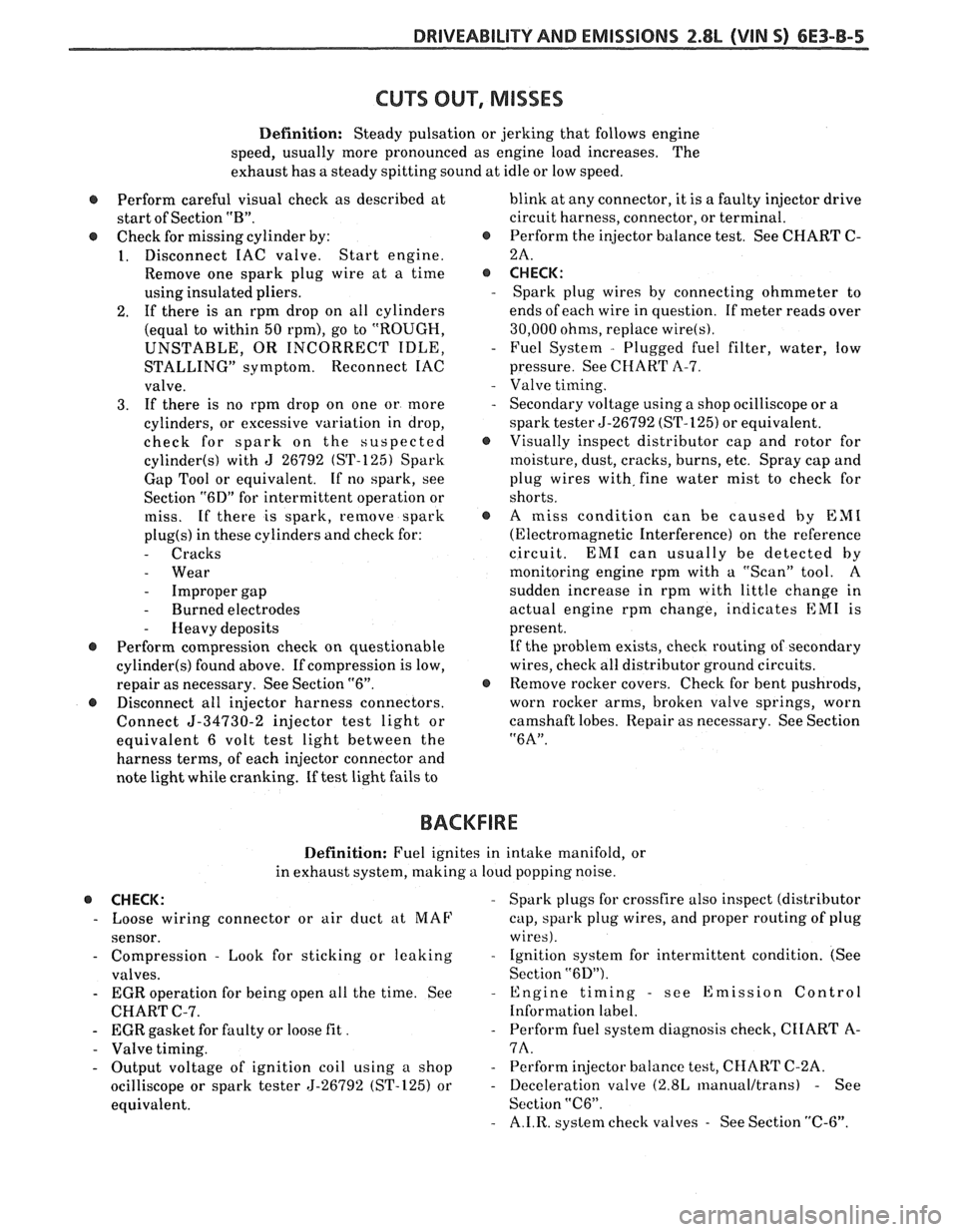
DWI\/EABILITV AND EMISSIONS 2.8L (VIN 5) 6E3-B-5
CU"T SUP, MISSES
Definition: Steady pulsation or jerking that follows engine
speed, usually more pronounced as engine load increases. The
exhaust has a steady spitting sound at idle or low speed.
@ Perform careful visual check as described at
start of Section
"B".
@ Check for missing cylinder by:
1. Disconnect IAC valve. Start engine.
Remove one spark plug wire at a time
using insulated pliers.
2. If there is an rpm drop on all cylinders
(equal to within
50 rpm), go to "ROUGH,
UNSTABLE, OR INCORRECT IDLE,
STALLING" symptom. Reconnect IAC
valve.
3. If
there is no rprn drop on one or more
cylinders, or excessive variation in drop,
check for spark on the suspected
cylinder(s) with J 26792 (ST-125) Spark
Gap Tool or equivalent.
If no spark, see
Section
"6D" for intermittent operation or
miss. If there is spark, remove spark
plug(s) in these cylinders and check for:
- Cracks
- Wear
- Improper gap
- Burned electrodes
- Iieavy deposits
@ Perform compression check on questionable
cylinder(s) found above. If compression is low,
repair as necessary. See Section
"6".
@ Disconnect all injector harness connectors.
Connect
5-34730-2 injector test light or
equivalent 6 volt test light between the
harness terms, of each injector connector and
note light while cranking. If test light fails to blink
at any connector, it is a faulty injector drive
circuit harness, connector, or terminal.
@ Perform the injector balance test. See CHART C-
2A.
s CHECK:
- Spark plug wires by connecting ohmmeter to
ends of each wire in question. If meter reads over
30,000 ohms, replace wire(s1.
- Fuel System - Plugged fuel filter, water, low
pressure. See
CHART A-7.
- Valve timing.
- Secondary voltage using a shop ocilliscope or a
spark tester 5-26792 (ST-125) or equivalent.
@ Visually inspect distributor cap and rotor for
moisture, dust, cracks, burns, etc. Spray cap and
plug wires with, fine water mist to check for
shorts.
@ A miss condition can be caused by EM1
(Electromagnetic Interference) on the reference
circuit.
EM1 can usually be detected by
monitoring engine rpm with a "Scan" tool. A
sudden increase in rpm with little change in
actual engine rpm change, indicates
EM1 is
present. If the problem exists, check routing of secondary
wires, check all distributor ground circuits.
@ Remove rocker covers. Check for bent pushrods,
worn rocker arms, broken valve springs, worn
camshaft lobes. Repair as necessary. See Section
"6A".
BACKFIRE
Definition: Fuel ignites in intake manifold, or
in exhaust system, making a loud popping noise.
CHECK:
- Loose wiring connector or air duct at MAF
sensor.
- Compression - Look for sticking or leaking
valves.
- EGR operation for being open all the time. See
CHART C-7.
- EGR gasket for faulty or loose fit .
- Valve timing.
- Output voltage of ignition coil using a shop
ocilliscope or spark tester 5-26792 (ST-125) or
equivalent.
- Spark plugs for crossfire also inspect (distributor
cap, spark plug wires, and proper routing of plug
wires).
- Ignition system for intermittent condition. (See
Section
"6D").
- Engine timing - see Emission Control
Information label.
- Perform fuel system diagnosis check, CIIART A-
7A.
- Perform injector balance test, CHART C-2A.
- Deceleration valve (2.8L ~nanualltrans) - See
Section
"C6".
- A.I.R. system check valves - See Section "C-6".
Page 720 of 1825
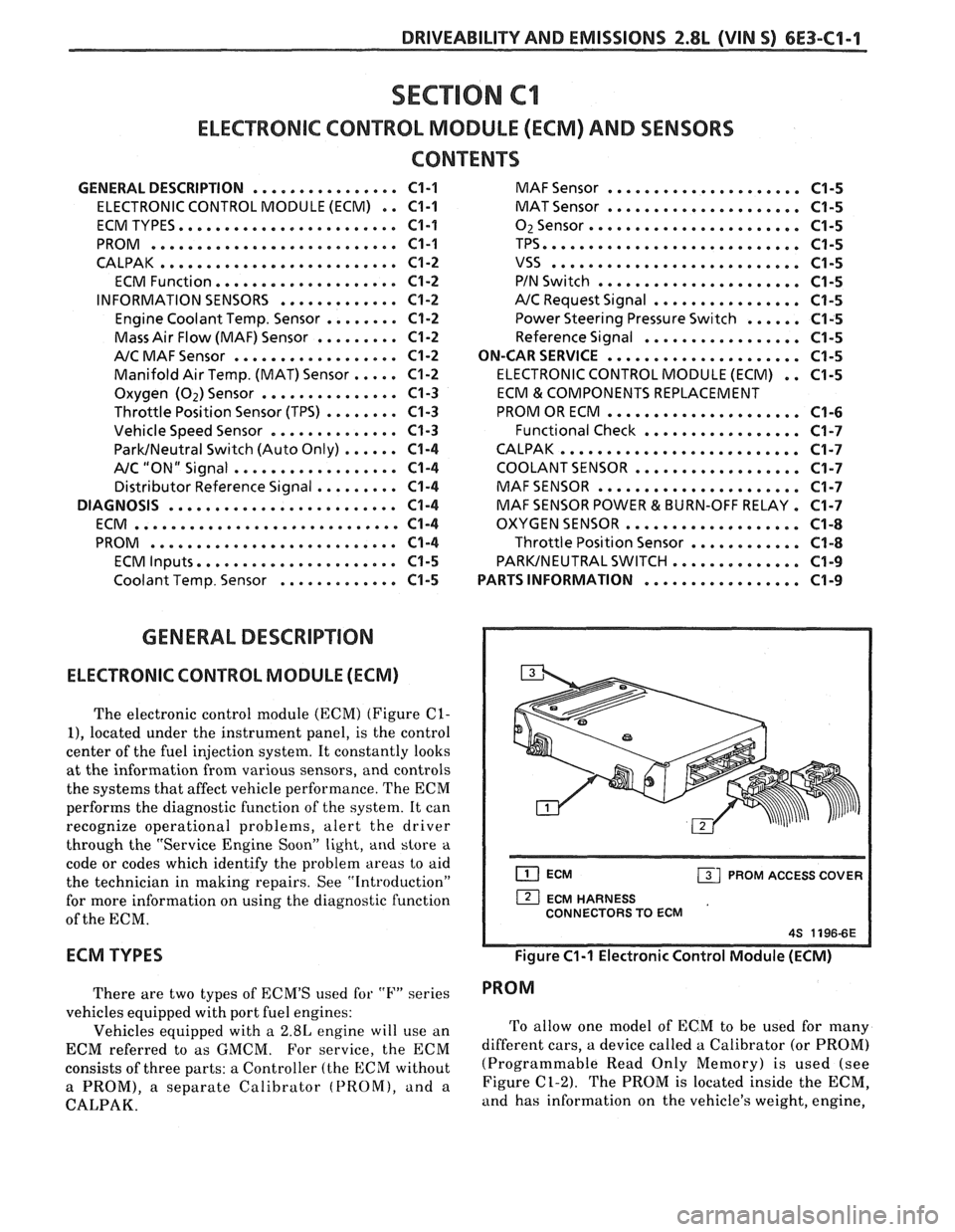
DRIVEABILITY AND EMISSIONS 2.8L WIN S) 6E3-C1-1
SECTION C1
ELECTRONIC CONTROL MODULE (ECM) AND SENSORS
CONTENTS
GENERAL DESCRIPTION ................ C1-1 MAF Sensor ..................... C1-5
ELECTRONIC CONTROL MODULE (ECM) , . C1-1 MAT Sensor ..................... C1-5
ECMTYPES.. ...................... C1-I O2 Sensor ....................... C1-5
PROM ........................... C1-1 TPS............................ C1-5
CALPAK .......................... C1-2 VSS ........................... C1-5
ECM Function..
.................. C1-2 PIN Switch ...................... C1-5
INFORMATION SENSORS ............. C1-2 A/C Request Signal ................ C1-5
........ Engine Coolant Temp. Sensor C1-2 Power Steering Pressure Switch ...... C1-5
Mass Air Flow (MAF) Sensor ......... C1-2 Reference Signal ................. C1-5
A/C MAF Sensor .................. C1-2 ON-CAR SERVICE ..................... C1-5
..... Manifold Air Temp. (MAT) Sensor C1-2 ELECTRONIC CONTROL MODULE (ECM) . . C1-5
Oxygen (Oz) Sensor ............... C1-3 ECM & COMPONENTS REPLACEMENT
........ Throttle Position Sensor (TPS) C1-3 PROMORECM ..................... C1-6
Vehicle Speed Sensor
.............. C1-3 Functional Check ................. C1-7
...... ParkINeutral Switch (Auto Only) C1-4 CALPAK.......................... C1-7
AIC "ON" Signal .................. C1-4 COOLANTSENSOR .................. C1-7
Distributor Reference Signal
......... C1-4 MAFSENSOR ...................... C1-7
DIAGNOSIS ......................... C1-4 MAF SENSOR POWER & BURN-OFF RELAY. C1-7
ECM .......e.........e........... C1-4 OXYGENSENSOR ................... C1-8
PROM ........................... C1-4 Throttle Position Sensor ............ C1-8
ECM Inputs..
.................... C1-5 PARKJNEUTRALSWITCH .............. C1-9
Coolant Temp. Sensor ............. C1-5 PARTS INFORMATION ................. C1-9
GENERAL DESCRIPTION
ELECTRONIC CONTROL MODULE (ECM)
The electronic control module (ECM) (Figure C1-
I), located under the instrument panel, is the control
center of the fuel injection system. It constantly looks
at the information from various sensors, and controls
the systems that affect vehicle performance. The ECM
performs the diagnostic function of the system. It can
recognize operational problems, alert the driver
through the "Service Engine Soon"
light, and store a
code or codes which identify the problem areas to aid
the technician in making repairs. See "Introduction"
for more information on using the diagnostic function
of the ECM.
ECM TYPES
There are two types of ECM'S used for "I?" series
vehicles equipped with port fuel engines:
Vehicles equipped with a
2.8L engine will use an
ECM referred to as GMCM. For
service, the ECM
consists of three parts: a Controller (the ECM without
a PROM), a separate Calibrator (PROM), and a
CALPAK.
ECM PROM ACCESS COVER I
1 ECM HARNESS
CONNECTORS TO ECM
Figure C1-1 Electronic Control Module (ECM)
PROM
To allow one model of ECM to be used for many
different cars, a device called a Calibrator (or PROM)
(Programmable Read Only Memory) is used (see
Figure
C1-2). The PROM is located inside the ECM,
and has information on the vehicle's weight, engine,